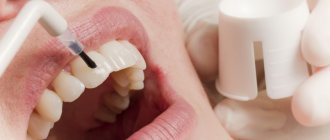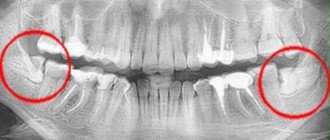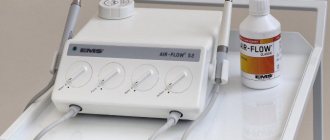5951
Teeth grinding is a procedure aimed at achieving two goals at once: on the one hand, there are fewer bacteria on smooth enamel, the rate of plaque formation is reduced, on the other hand, teeth become lighter.
That is, this manipulation is another step towards a healthy and attractive smile.
Process technique
In dentistry, grinding refers to the leveling of enamel through mechanical action . You should not try to perform a similar procedure at home, because... Without professional skills, it is easy to damage the enamel.
This manipulation is part of a single complex for treating the surface of the teeth: it follows immediately after professional cleaning , thanks to which the oral cavity gets rid of contaminants.
At the same time, the procedure precedes the polishing stage , with which it is closely related.
Professional cleaning and grinding of the teeth place local stress on the enamel. Polishing, on the contrary, thanks to the application of special compounds, acts as a protective manipulation for the surface.
What is polishing
Polishing belongs to the category of professional cleaning. This is a dental procedure that is prescribed after each dental procedure. Polishing has several useful properties:
- Teeth become smooth and white.
- breath disappear .
- Prevents dental diseases.
The polishing procedure ultimately gives not only the external effect of whitening and smoothness, but also disarms the surface of the incisors, providing protection against the development of oral diseases.
In what cases is it necessary
Grinding of teeth followed by polishing is carried out to achieve the following goals :
- The need for post-processing after cleaning from unwanted plaque and tartar: the procedure is an effective method in a preventive complex designed to prevent the occurrence of such problems in the future.
- Achieving the most comfortable state for the patient .
The surface of the dentition, which has undergone professional cleaning, becomes noticeably rough. This is the result of exposure to abrasive particles used in dentistry. To avoid discomfort, roughness must be removed by grinding. - Grinding at the separation level is a necessary part of treatment in orthodontics: it is performed before and after installing braces.
In addition, grinding accompanies the filling procedure to give the desired shape to a tooth that has undergone any physical impact from the dentist.
When installing fillings, cements and pastes that have a plastic consistency are used. However, when hardened, these compositions do not take on a shape that would correspond to the natural anatomical one.
To remove protruding particles, selective grinding is used, which is especially important on the front teeth.
Failure to do this procedure may lead to negative consequences.:
- patient complaints that he feels “something extra” in his mouth;
- Curvature even at the level of one unit can lead to malocclusion.
- irritation of the mucous membrane, because with the increased sensitivity of these tissues, any foreign object, even special dental compounds, can cause damage and contribute to the development of inflammatory processes.
Read how you can strengthen your gums at home in a new publication.
In this material we will tell you what to do if a piece of front tooth enamel breaks off.
Here https://www.vash-dentist.ru/krasota-i-uxod/otbelivanie/opalescence.html we’ll talk about whether the Opalescence system is suitable for home teeth whitening.
This procedure has a fairly short number of contraindications; it is impossible to carry out if you have:
- viral infections (like any other dental procedure, with the exception of extremely urgent ones),
- inflammation of the oral cavity,
- untreated pathologies (caries, bleeding),
- too thin enamel.
In any case, you should first contact your dentist for advice.
Polishing effect
After professional hygiene, the oral cavity is considered completely cleansed and will have high resistance to various pathogenic influences for some time. The final polishing stage has the following effects:
- noticeable teeth whitening;
- uniform enamel color due to the removal of all stubborn dirt;
- smooth, pleasant surface of the teeth;
- visible shine of enamel;
- further prevention of inflammation and plaque deposits;
- improving the quality of restoration;
- correction of tooth shape after filling;
- getting rid of unpleasant odor;
- restoration of the natural properties of enamel.
As a result of polishing, teeth gain the ability to cope with negative influences and food loads, as well as avoid oral infections.
Sequence
Grinding of the tooth surface is most often done using classical technology .
The traditional approach involves the use of a drill and special pastes with a granular structure. The dentist has a number of special instruments, as well as ultrasonic attachments and drill tips.
Pastes are used in a certain sequence - from higher to lower grain levels:
- first, a coarse paste is applied, with which the dentist cleans off the largest fragments;
- further – medium-grained;
- at the final stage, a fine-grained composition is used, which removes the smallest particles of abrasive material.
This contributes to the most adequate smoothing of irregularities. This method is relevant for correcting the shape of a tooth.
For the purpose of grinding enamel, other sets of auxiliary materials are also used. For example, fine-grained burs are used, as well as corundum heads.
The dentist also resorts to using a set of special heads, strips and discs during the subsequent stage - polishing. Specialized paste-like compositions are used. At the end of the procedure, fluoride preparations are used.
The process is not inherently complicated: a special composition is applied and the surface is processed using a tool (brush, cap, tip, etc.).
Traditional grinding is gradually being replaced by the technology of using air masses for the same purpose. The equipment is built on the principle of functioning of a mini-sandblasting tool for grinding.
The result of the impact is the removal and removal of tissues that have become a “victim” of the reaction with abrasive particles.
Professionals note that air grinding has a number of advantages over classical grinding:
- It is devoid of all the physical disadvantages of the drill, which cause discomfort for the patient and partly for the dentist himself: temperature, pressure, noise and vibration do not accompany this procedure.
- There is no need to inject large amounts of anesthesia. Local impacts are possible.
- Less risk of damage to tissue and tooth enamel.
- The procedure is faster and requires less effort on the part of the doctor.
Thus, air grinding is a progressive method in dentistry. However, the option of partially exaggerating the positive features of the method for advertising purposes cannot be ruled out.
Already today, opponents of this approach note a number of disadvantages, for example, a significant increase in the sensitivity of the enamel after the procedure, the impossibility of use in deep cavities reaching the level of the pulp.
Also, only composite material is susceptible to the influence of air, while compositions using silver cannot be adjusted in this way.
For another type of tooth enamel grinding – stripping, watch the video:
Polishing tools
The entire polishing process is carried out using several replaceable attachments on a drill. An abrasive paste is applied to the working surface, after which the enamel is exposed at high speeds.
The following attachments are available:
- in the form of a rubber bowl - for flat surfaces;
- a cone-shaped brush - for treating natural tubercles on distant teeth;
- strips - for hard-to-reach areas, including the interdental area.
Special pastes contain silica, silicate, zircon, xylitol and fluorine. They are distinguished by abrasiveness:
- high degree - eliminates dense stains;
- medium degree - polishing of small deposits;
- low degree - polishing of color irregularities;
- very low level - maximum softness to complete polishing.
Is it painful to do?
Unfortunately, teeth grinding is a rather unpleasant procedure. Painful sensations cannot be avoided even with the use of modern technologies.
It is necessary to understand that this manipulation involves the use of drugs that will temporarily desensitize the area of the oral cavity that will undergo the intervention. Local anesthesia is usually used .
About ways to care for teeth with braces, our next review.
In the next article, we will discuss whether lemon essential oil can be used to whiten teeth.
At the link https://www.vash-dentist.ru/krasota-i-uxod/narashhivanie/klyikov.html you will find a video of how the canine extension procedure takes place.
This applies to cases where the body of the unit itself is sharpened. At the same time, removing and smoothing out excess particles that appeared when using filling material is not a painful procedure, but rather unpleasant.
It is worth considering: for some time after the procedure, tooth enamel will be more sensitive than usual. The duration of the period depends on the individual characteristics of the organism.
Eating very hot or cold, solid foods may be problematic during this time.
Ideally, you should try to protect the enamel from such influences until the end of this stage.
Is there any harm to enamel?
If the technology is followed properly, there is no need to worry about the condition of the oral cavity in general, and enamel in particular, as a result of this procedure. She is absolutely harmless.
Moreover, periodic visits to the dentist for professional cleaning followed by grinding and polishing are necessary to avoid the formation of tartar and the subsequent development of pathologies.
Thus, teeth grinding provides professional care and is not harmful to the enamel . A pleasant “bonus” for undergoing the procedure will be the acquisition of a more attractive smile appearance.
Contraindications
Despite the large number of positive actions, this procedure has a number of prohibitions. If the doctor detects an alarming symptom in the patient, this becomes the reason for refusing to prescribe the procedure. Main contraindications:
- Bleeding gums.
- Acute periodontitis.
- Deep caries.
- Hypersensitive enamel.
- Inflammation in the oral cavity.
Before cleaning your teeth, you need to treat other oral disorders that may interfere with the procedure.
Aftercare recommendations
The recommendations are mainly due to the fact that teeth become sensitive after the procedure. That is, you should avoid eating foods that seem very hot or cold.
It is also worth giving up too hard foods for a while. All this can be adjusted by trusting your own feelings regarding pain and comfort.
There are also specific tips. Thus, doctors recommend minimizing the consumption of foods that have a “coloring” effect. We are talking not only about certain berries, but also, above all, about tea and coffee.
This measure must be observed for two weeks in order to maintain the pleasant appearance of the cleaned enamel. You can at least switch to green tea at this time. You should also try to minimize smoking.
How to reduce the risk of pain?
Simple measures will help reduce discomfort after cleaning and unsealing:
- give up too hot, cold, spicy, sour and sweet foods - they will irritate inflamed or damaged tissues,
- clean the affected area of the jaw more carefully, try not to chew hard food with it - any mechanical impact can slow down recovery and increase pain,
- Try to eat right and get enough rest - this will speed up recovery.
If the treatment was carried out correctly, the discomfort should disappear after a few days.
Price
The teeth grinding procedure is far from the most expensive in dentistry. For one jaw, its price varies around 1000 rubles, which for one unit is usually 100-200 rubles.
However, you need to understand that the impact of this type on one tooth is usually included in the complex of treatment of this unit, most often its filling.
Enamel polishing , on the contrary, is usually highlighted in the price list and is provided as a separate service. However, it would be reasonable to decide on a one-time payment for comprehensive oral hygiene. In this case, you will need to pay a little more than two thousand rubles for one jaw.
Reviews
Patients who have successfully completed the procedure note that the result debunks the myth about subsequent tooth decay. Moreover, they often write that teeth begin to look whiter and more beautiful.
Sometimes they complain of increased sensitivity, as a result of which they cannot live a normal life, for example, drink hot coffee in the morning. But a small percentage of negative reviews, most of which were the result of the dentist’s unprofessionalism, suggests that in general this procedure is useful and safe.
You can share your opinion in the comments to this article.
If you find an error, please select a piece of text and press Ctrl+Enter.
Tags: tooth enamel professional teeth cleaning ultrasonic teeth cleaning teeth cleaning
Did you like the article? stay tuned
Previous article
Biohorizon implants: features of installation and engraftment
Next article
What determines the service life of dental implants?
Write a comment
Ksenia
August 8, 2016 at 6:38 am
I went to the dentist for a grinding procedure. The doctor with whom I had dental treatment advised me to do it; he said that grinding is also used to clean the surface of teeth from complex plaque and stones. And since I drink a lot of coffee, I need this procedure. Yes, I can’t say that the procedure is pleasant, after all, these are medical, albeit hygienic, manipulations, but I really liked the result. The teeth became smoother, shine appeared, plaque and stones were cleared. It is worth considering that the effect is quite individual, many complain that tooth sensitivity appears, I took this point into account and specifically a week before grinding, and a week after, I brushed my teeth with a special paste that reduces tooth sensitivity.
Alexander
August 9, 2016 at 4:27 am
I've seen enough Hollywood films and I also wanted a snow-white smile. Friends said that it was harmful, that they would erase the enamel and then you would suffer for the rest of your life. First I consulted with a specialist, and then I spoke with the person who did the procedure. It turned out to be not harmful, but on the contrary, useful. Now I walk around with a mouth full of dazzling teeth and a smile from ear to ear. Now there's nothing to hide.
Vladimir
October 11, 2016 at 02:08 pm
Since childhood, I have a terrible stomach for dentists, but from smoking and coffee, which I drink 5-10 times a day, my teeth have become not just yellow, but ugly. As a modern person, I immediately went to the Internet for advice and information, and immediately came across the answer to the question I posed. I plucked up courage and went to the dentist. This procedure turned out to be completely safe, and in some places it was even funny to watch the doctor’s actions. In general, I was pleased with the result, and after the instructions of my doctor, I began to take better and more careful care of my oral cavity!
Anastasia
October 24, 2016 at 8:55 am
I did this procedure once, when I discovered a cinnamon coating on my teeth, I thought it was caries. I ran to the doctor, and they told me that it was just tartar and that this problem is common. They offered to do ultrasonic cleaning - I really liked the result, no plaque, firstly, the procedure was painless and also inexpensive.
Denis
November 22, 2016 at 6:24 am
My teeth grinding went well. There was no particular pain, but mostly it was periodically unpleasant to feel the machine buzzing in your mouth and scraping something. The doctor recommended grinding at least once a year. Because I smoke and love coffee very much, and after some time plaque forms on my teeth, especially on the inside. The procedure is not expensive, and after it your teeth sparkle with whiteness.
Svetlana
October 31, 2022 at 10:23 am
Every year I go through the polishing procedure. As a result, there is no plaque and the teeth are healthier; there have been no caries for three years now.
Installing a seal
Identifying the need for tooth filling
The dentist may use several methods to detect tooth decay, including the following:
- Examination
- Discolored areas on the surface of teeth can sometimes be signs of tooth decay. The dentist may use a dental probe—a metal instrument with a sharp tip—to identify the cavity. Healthy tooth enamel is hard and will withstand the pressure of the probe. The affected enamel is soft, and the probe will easily pierce it. The probe is used with caution: too much pressure from the probe can damage a healthy tooth, and the probe can spread bacteria, which will lead to the development of caries on other teeth. - Cavity Dye
- This dye is applied by the dentist to the surface of the tooth enamel. It lingers on the affected areas and is easily washed off from the surface of healthy teeth. - X-rays
- X-rays can detect decay developing on the enamel of the sides of the tooth where it touches other teeth, as well as in the layer of dentin underlying the enamel. At the same time, X-ray radiation often does not accurately detect small carious cavities on the chewing (occlusal) surface of the tooth. Existing fillings and other restorative materials may also prevent the cavity from being identified. - Laser Fluorescence Cavity Detection
- This method involves assessing changes caused by caries using a small laser probe. This device is especially useful when examining the chewing surfaces of large and small molars.
Caries is not the only reason that requires tooth filling. Other reasons include:
- Fracture or crack of a tooth;
- Abrasion of the surface of teeth as a result of careless treatment of them, for example: Biting nails;
- Teeth grinding (bruxism);
- Opening various objects with teeth.
Dental filling procedure
Before filling a tooth, your dentist may, if necessary, administer a local anesthetic to numb the area being treated. The dentist then removes decay from the surface of the tooth using a dental drill. Lasers can also be used to remove tooth decay.
The drill, namely its dental handpiece, is equipped with a metal cone called a bur, which cuts through the enamel and removes tissue affected by caries. Burs come in different shapes and sizes. The dentist selects the appropriate bur depending on the size and location of the carious cavity.
First, the dentist uses a high-speed handpiece (which makes a familiar buzzing sound) to remove decay from unsupported areas of enamel. Once the bur reaches the dentin, the second layer of the tooth, the dentist may use a lower speed handpiece because dentin is softer than enamel.
After removing the decay, the dentist treats the cavity, preparing it for a filling. Each type of filling requires a specific processing method that ensures its fixation. The dentist may use a liner as the base of the filling to protect the dental pulp (the layer that contains the nerves). Such a support may include a composite resin, glass ionomer, zinc oxide and eugenol, or other materials.
Some of these materials release fluoride, which prevents further tooth decay.
If the dentist uses a buildable filling, he first etches (treats) the surface of the tooth with an acid-containing gel. Etching leads to the formation of small depressions in the tooth enamel, which are filled with a composite material during filling. A bonding material is also used, which ensures a double connection between the filling and the tooth. Using buildable fillings can reduce the risk of developing tooth decay under the filling. Tooth augmentation is usually performed using composite fillings.
Certain types of fillings harden under the influence of special radiation. In such cases, the dentist will apply the filling material in layers, stopping several times to treat the resin with radiation. This procedure ensures drying (hardening) of the material and strengthens it.
After completing the filling, the dentist finalizes and polishes the tooth using burs.
After teeth filling
Some people experience increased tooth sensitivity after filling. A filled tooth may react to external pressure, air, sweet or cold foods. Increased tooth sensitivity is most often caused by composite fillings, but this can also occur when using other types of filling materials.
The most common cause of pain that occurs immediately after the anesthetic wears off is an excessive filling height. In this case, make an appointment with your dentist as soon as possible to reduce the height of the filling.
The second type of discomfort can be a sharp electric shock that occurs only when the teeth touch. This shock is called galvanic shock and is caused by the contact of two metal fillings (the filling on the recently filled tooth and the filling on the opposite tooth), which creates an electric current in the oral cavity. Such cases are possible, for example, if the new filling on the lower tooth is made of amalgam, and a gold crown is installed on the upper tooth opposite it.
In most other cases, sensitivity subsides within one or two weeks. Before this period expires, try to avoid the influence of all unfavorable factors. If the tooth is extremely sensitive and the sensitivity does not subside even after two weeks, contact your dentist.
It is important to tell your dentist about any pain you experience so that when you apply your next filling, he or she can select a different material and make changes to reduce the sensitivity. Different people have different responses to types of filling materials, and your dentist cannot predict how your tooth will react to a particular type of material.
Try to describe your pain sensations to the dentist as accurately as possible. Depending on the information you provide, further actions will be determined. The dentist may remove the filling and apply a new one, or they may also insert a lining or a substance that reduces the sensitivity of the tooth. If the cavity being filled is very deep, root canal treatment may be necessary to correct the problem.
After the filling is placed, the dentist polishes it, but sometimes sharp edges may remain. Due to the anesthesia, you may not feel them at first. If you notice any sharp edges, contact your dentist as soon as possible and arrange to have the tooth surface smoothed to avoid damage to your tongue and mouth.
Temporary fillings
Temporary fillings (usually white, off-white or gray) are applied in the following cases:
- Treatment requires more than one visit;
- The dentist considers it necessary to wait time for the tooth to heal;
- You have a deep cavity and during treatment the pulp (the layer containing nerves and blood vessels) is exposed;
- You require emergency dental treatment.
A temporary filling can improve the condition of the tooth because it covers the tooth, protecting the pulp from bacteria and easing sensitivity.
Temporary fillings often contain eugenol, an ingredient in over-the-counter toothache treatments. Eugenol is also found in clove oil, traditionally used to relieve toothache.
Temporary fillings are not designed to last long. They usually fall out, crack, or wear out within one to two months. After applying a temporary filling, be sure to replace it with a permanent one, otherwise the tooth may become infected or other types of damage may occur.
Reasons for replacing fillings
Fillings don't last forever. They may become discolored. Composite fillings, which are the color of natural teeth, become stained, yellowed, or darkened over time. When chewing, the teeth and the fillings that cover them are subjected to very strong pressure. Even if there is no other damage, some fillings wear out over time and require replacement. The seal may require earlier replacement if it falls out, loses its tightness, or develops cracks.
A cracked or leaking filling can allow bacteria and food particles to penetrate. Since you cannot brush such areas, bacteria can feed on leftover food and produce acid, which causes dental caries. The cavity formed under the filling can grow significantly before you notice it or feel pain. Therefore, you should regularly check the condition of fillings and replace them if damage is detected.
Fillings falling out
Fillings can fall out for several reasons:
- When chewing, too much pressure is applied to a tooth that has a large filling, which destroys the filling or tooth.
- The material used to apply the filling cannot withstand the pressure that is applied to it. For example, if you have a large portion of your front tooth chipped, a porcelain crown (the color of your natural teeth) may be the best solution. In some cases, the dentist may place a composite filling instead. This may look secure and acceptable, but if the seal is too large, the plastic may break off if you bite hard on food.
- When a filling is applied, saliva enters the cavity being filled. If the filling consists of composite resins, saliva will disrupt the binding of the filling material, as a result of which it will not be able to attach firmly enough to the surface of the tooth and will fall out over time.
Formation of cracks in fillings
Both amalgam and composite fillings can crack either soon after they are placed or over time.
Cracks can occur soon after the filling is installed if the filling rises above the rest of the tooth surface and is therefore subject to the strongest pressure when biting food. Cracks can also form over time as the filling and the restored tooth experience pressure from biting and chewing food.
Also, small cracks may form along the edges of the filling, which are usually caused by its gradual abrasion. Such cracks can often be repaired.
Loss of seal tightness
A filling is said to have lost its integrity if one of its sides is not tightly connected to the surface of the tooth, as a result of which food debris and saliva can penetrate into the gap between the filling and the tooth. This can lead to tooth decay, discoloration, and tooth sensitivity.
Both amalgam and composite fillings can lose their seal. Amalgam fillings sometimes lose their seal a little after they are placed. You may notice this by increased sensitivity to cold foods. This sensitivity weakens over the next two to three weeks and then disappears completely. During this period, the amalgam filling undergoes natural corrosion, which leads to the closing of the gap at the edges of the filling and elimination of the leak.
A composite filling can be contaminated by saliva, which weakens the chemical bond between the filling and the tooth and leads to loss of seal. In other cases, small gaps may occur where the tooth and filling come into contact. Such gaps may be the result of the filling drying out after its application. The increased sensitivity that occurs after applying a composite filling may disappear over time. If this does not happen, the filling must be replaced.
Seals may lose their tightness as a result of their gradual abrasion. Such fillings need to be replaced.
Abrasion of fillings
Some fillings can last for 15 years or more. Others require replacement after 5 years. The dentist can determine how worn the filling is and whether it needs to be replaced.
Jaw clenching and teeth grinding
The habit of clenching your jaw and grinding your teeth can damage your fillings. The pressure exerted on the teeth can increase their sensitivity and accelerate the wear of fillings. Jaw clenching and teeth grinding also causes cracks in teeth and fillings, or widens existing hairline cracks—thin cracks that can be seen when shining a light on the tooth.
Rules for caring for fillings
Although some fillings can last for many years, the average lifespan of an amalgam filling is about 12 years, and composite fillings can break down even faster.
Your dentist should check the condition of your fillings as part of your regular checkup. An x-ray may be necessary if the dentist needs to check for cracks or leaks in the filling or decay underneath it. You should make an appointment with a dentist in the following cases:
- Increased tooth sensitivity;
- Crack detection;
- Part of the filling appears to have fallen out.
Visit your dentist regularly for professional oral hygiene and brush your teeth with fluoride toothpaste and floss once a day. If you have many fillings or very large fillings, your dentist may prescribe a fluoride gel that you can apply at home. The use of fluoride will strengthen tooth enamel and prevent the formation of new carious cavities. Also, during the examination, the dentist or dental hygienist may coat the filled teeth with fluoride varnish.
In addition, you can use rinses that reduce the level of acids in the mouth, and therefore the number of bacteria that cause tooth decay. This will reduce the formation of new carious cavities.
If your fillings are cracked, you may want to ask your dentist about using night guards. Wearing them at night will prevent jaw clenching and teeth grinding during sleep.
Replacing fillings
Before removing the filling, your dentist will give you treatment options. It is often possible to restore an old filling without replacing it completely. However, if the filling needs to be completely replaced, the dentist may change the filling material used. Tell your dentist your wishes regarding the appearance of the filling, then he will be able to choose the material that best suits you.











